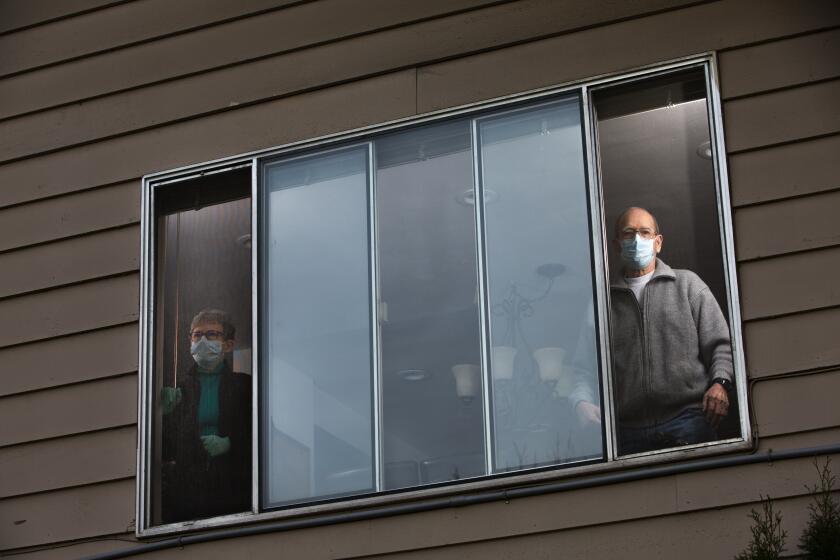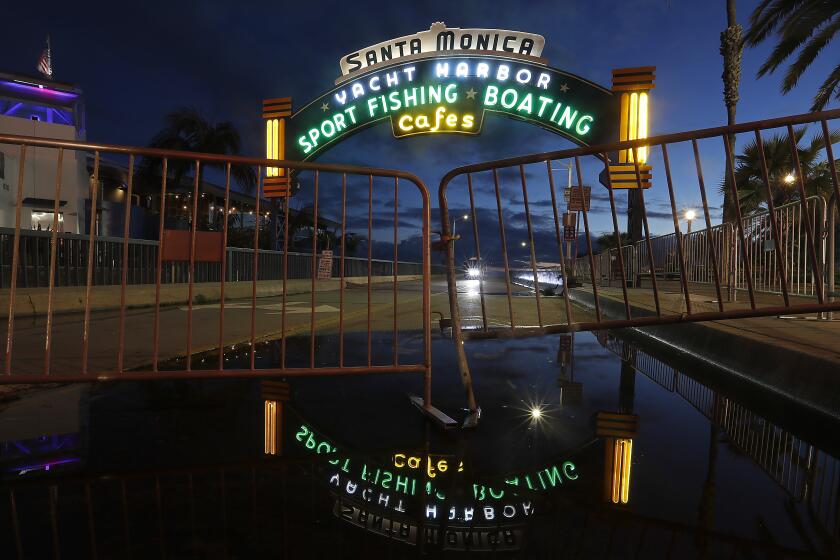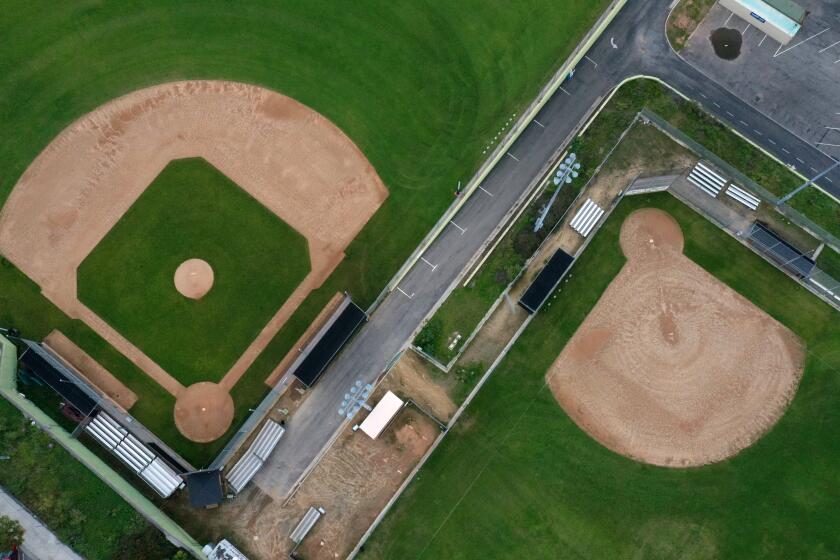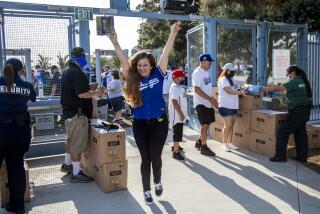L.A. imposes more restrictions on outdoor activities as coronavirus death toll increases
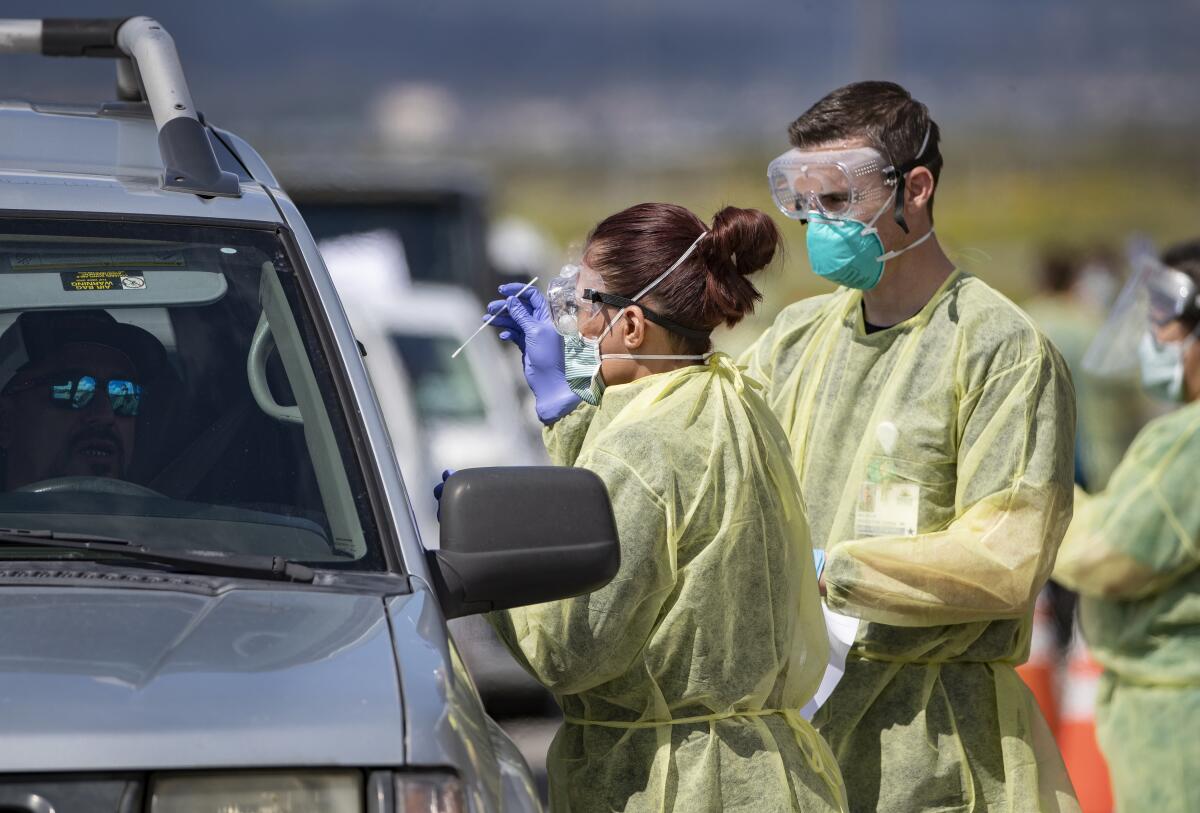
Mayor Eric Garcetti on Sunday said Los Angeles residents need to do a better job of following orders to practice social distancing, announcing the closure of city golf courses, group sports facilities and beach parking lots in Venice.
The weekend was marked by growing alarm from public officials as many people, rather than staying close to home, packed beaches, parks, and hiking and bike trails.
“This weekend we saw too many images of too many people crowding beaches or canyons beyond their capacity,” Garcetti during a Sunday evening briefing. “Too many people, too close together, too often. The longer we do that, the more people will get sick, and the more people will die. There’s no way to sugarcoat that.”
On Sunday afternoon, the Mountains Recreation and Conservation Authority announced that it was closing its popular parks and trails, including the parkland owned by the Santa Monica Mountains Conservancy. Parking lots and access roads also will be closed.
The Santa Monica Mountains National Recreation Area also announced some closures at Solstice Canyon beginning Monday. And earlier Sunday, the city of Santa Monica announced that it also would close its beach parking lots because of the “large number” visitors and advised people to avoid the beaches, bike paths and Palisades Park.
“Today is not the day to go to the beach,” City Manager Rick Cole said in a statement. “We know that it’s difficult to stay at home when the weather is so nice, and being close to the beach is one of the primary reasons why we love to call Santa Monica home. Yet this is a time when we must take the guidelines from our health officials to heart.”
Garcetti said officials would consider closing beaches if necessary. Late Sunday, the Laguna Beach Police Employees’ Assn. released a statement pressing the Laguna Beach City Council to close all city beaches and parks immediately.
The pleas came as the number of California coronavirus cases reached 1,793, with 35 deaths.
On Sunday night, President Trump approved a request by Gov. Gavin Newsom to declare a major disaster in the state to help it respond to the pandemic with “mass care” emergency assistance, unemployment aid and disaster legal services, among other relief.
“Unfortunately, California has been disproportionately impacted by COVID-19,” Newsom wrote to Trump. “Besides California being home to nearly 40 million people, which itself poses significant logistical issues few other states face, California partnered with the federal government in several extremely complex and challenging repatriation missions, which strained California’s resources and impacted California’s healthcare delivery system.”
Trump said the Federal Emergency Management Agency would be shipping mobile hospital units to the state within the next 48 hours. California is in line to get eight of them for a total of 2,000 beds. New York and Washington states will get 1,000 beds each, he said.
The Navy hospital ship Mercy, which is based in San Diego, also will be deployed to Los Angeles. The ship can be on station in L.A. in “a week or less,” FEMA Administrator Peter Gaynor said. It would not be used to treat COVID-19 patients but to take other patients in an attempt to relieve the burden on hospitals, Gaynor said.
In addition, Trump announced that he has signed paperwork to have the federal government pay for National Guard deployments in California, New York and Washington. The National Guard will remain under the control of state governments, but the federal government will cover the cost, as is typical in disaster scenarios.
Newsom on Friday deployed the California National Guard to assist food banks statewide that are serving residents whose needs have not been met because of supply chain problems and temporary food shortages during the pandemic.
The rapid-fire announcements came as Los Angeles County on Sunday reported an additional death related to the virus, the county’s fifth. The Culver City resident was older than 65 and had underlying health conditions, the county Department of Public Health said.
The county recorded 71 new cases of the coronavirus, bringing the total to 409; 132 of those were announced in the past 48 hours. Eighty-four people have been hospitalized, public health officials said.
“Please know that the actions you take today to stay 6 feet away from others and limit all non-essential activities outside your home are the best way for us to slow the spread of COVID-19 and save lives,” Barbara Ferrer, the county public health director, said in a statement.
The first inmate within California’s prison system has tested positive for COVID-19 at California State Prison, Los Angeles County, state corrections officials announced on Sunday night.
The officials also said that five workers have tested positive for COVID-19. Two are at California State Prison, Sacramento, outside of Folsom; one is at Folsom State Prison; and two are at the California Institution for Men in Chino.
The prisoner in L.A. County was in stable condition and being treated on site, according to a statement from the California Department of Corrections and Rehabilitation.
Riverside County on Sunday also reported another death related to the virus, the sixth there. Information about the person who died was not immediately available.
And Monterey County announced its first death of a resident due to complications from the virus. The person was hospitalized and had an underlying medical condition, officials said Saturday.
“We are facing a historic public health challenge and know this is a very difficult time,” Dr. Edward Moreno, the county health officer and director of public health, said in a statement.
Experts, meanwhile, warned that the number of U.S. deaths would rise in the months ahead.
Dr. Anthony Fauci, the government’s top infectious-diseases specialist, said Sunday that although the United States was “not necessarily” on the same trajectory as that of Italy — which has the world’s largest coronavirus-related death toll — “we’re going to get hit, there’s no doubt about it.”
Fauci, director of the National Institute of Allergy and Infectious Diseases at the National Institutes of Health, said in an interview on CBS’ “Face the Nation” on Sunday that some aspects of Italy’s crushing death toll, which reportedly tops 5,000, were not yet fully understood by scientists.
“If you look at the dynamics of the outbreak in Italy, we don’t know why they are suffering so terribly,” he said, adding that “many of us believe that early on they did not shut out as well the input of infections that originated in China and came to different parts of the world.”
U.S. prospects may have been improved by bans on travel from China and Europe.
“We have from the beginning been able to put a bit of a clamper” on outside cases, Fauci said.
A Los Angeles County Superior Court judge on Sunday ordered the Sylmar Courthouse closed for three days after a deputy public defender assigned to the courthouse tested positive for COVID-19, the illness caused by the coronavirus, the court said in a news release.
Presiding Judge Kevin Brazile was notified Saturday that the attorney had tested positive last week after caring for a relative who also tested positive, the court said. Affected judges and staff will self-quarantine for 14 days, it said.
The courthouse handles juvenile delinquency cases in two courtrooms, and both have been cleaned and disinfected, officials said. Cases on the calendar for the next three days have been moved to the Michael D. Antonovich Antelope Valley Courthouse in Lancaster. The Sylmar Courthouse is scheduled to reopen Thursday.
Ten more cases of the coronavirus infection have been reported at a South Bay assisted living facility, the Kensington Redondo Beach, according to the Daily Breeze. Six of them are staffers, and four are residents, the paper reported.
Administrators said earlier in the week that one resident and two staff members had tested positive, raising fears of an outbreak in the high-end assisted living home.
Amid the steady rise in cases, Gov. Newsom on Saturday pleaded for residents to avoid unnecessary social contact after scattered reports across the state that some people had been flocking to the coast, gathering with friends or failing to follow social-distance orders.
The governor stressed that even those who didn’t show any symptoms of COVID-19, including young adults who appear to be less likely to become gravely ill if they do contract the illness, needed to cooperate for the good of others in their communities.
Being stuck at home during California’s coronavirus stay-at-home order has been challenging to many. Tell us how it has been for you.
The governor’s stay-at-home order will remain in effect until “further notice” and could be changed as conditions warrant, according to a statement released by the governor’s office. Issued under broad powers granted to the governor under the state’s Emergency Services Act, Newsom’s executive order is enforceable by law.
But people continued to crowd California’s beach areas Sunday, as recent rains gave way to mild weather.
At Torrance Beach, people were well spread out on the sand, but the narrow walking path beside it was jammed by 10 a.m.
At Long Beach’s Junipero Beach, besides the occasional mask- and glove-wearer, all seemed to be going as normal on Sunday morning.
The sun shone down on beach goers, young and old: basketball players using all three hoops, bikers, joggers, rollerbladers, men doing pull-ups on the outdoor exercise machines, women exercising on the grass, standing fewer than 6 feet apart.
Along the shore, a family of three, wearing masks, took a walk. A lone fishermen waded knee-deep in the water, with his family nearby. When he felt a tug, he called two children nearby to help pull the line. Strangers, including the family, gathered to see the spectacle up close.
On Friday, Long Beach Mayor Robert Garcia expressed frustration at his fellow residents for not following his guidance.
“Seriously people, you need to practice social distancing. I am seeing tons of people out there acting like there’s no crisis,” he wrote on his personal Twitter page.
Or possibly, it was the governor’s order that led people to the beach, to spend time outdoors in one of the few remaining places available.
At least for Jaushay Rockett, 36, that was the case.
“This may have sparked something,” he said. “This may have sparked people to be creative and go outside. It could be a good thing or it could be a bad thing.”
Rockett was playing basketball outside because “everything’s been closed,” including his usual indoor gyms and courts in Signal Hill and Compton, he said. Initially, he believed the order to stay indoors would be more strict, but he saw people outdoors seemingly living their lives as usual. It appeared there were more people at the beach than usual.
“I’m thinking it was gonna be like martial law,” he said. “Everybody is out … until they make it mandatory. They’re going to have to really lock down the city” for people to stay indoors.
Rockett was taking precautions to stay safe. He made sure to keep a distance from people, besides his family friends with whom he played ball. After a game, he said, he wipes his hands and the ball with Lysol and goes straight to the shower.
Clifford Aquino and Ryan Castro, both 28, were displaced from their gyms in Cerritos. They decided that Long Beach, where there are plenty of outdoor gyms and paths to run, would be a good replacement to get in a workout.
“This is only Day 2,” said Castro. “It sucks.”
“It does suck, but you have to find different ways to stay active,” Aquino said.
Aquino said he feels safe using the workout machines because he can keep his distance from people. If one area is too busy, he finds another, or chooses another activity to do. He said he wipes down each machine with Lysol wipes before using it.
Castro said he had been a consistent runner before, but stopped a while back. Now, because he has so few options, he’s getting back into it.
Both have gone hiking and tried different, also busy, beaches.
Maybe Californians just can’t help a little sunshine, Castro said.
“A little bit of sun while we have it, it’s like their last chance before the rain comes down,” he said. “Huntington Beach was worse than this.”
Eerie photos and stunning aerial shots show what California looks like under Gov. Newsom’s “stay at home” order.
In addition to pushing residents to heed social distancing orders, California leaders are also working to marshal much-needed resources to prepare for a possible surge in coronavirus-related hospitalizations.
Newsom said Tim Cook, chief executive officer of Apple, had pledged 1 million medical masks to be donated specifically to California’s coronavirus efforts. And he said manufacturers in Los Angeles’ garment district and in Northern California had reached out to sew additional masks if needed.
A key need in California and across the country is ventilators, necessary for some of the most serious COVID-19 patients, and the governor cited new efforts by two entrepreneurs to assist in producing the medical equipment. Newsom said that Elon Musk, CEO of Tesla Inc. and Space X, had promised to use the supply chains that support his companies for help in assembling ventilators. The governor also said that K.R. Sridhar, chief executive of Bloom Energy, agreed to help quickly modernize some 200 older ventilators that the state had on hand. The original manufacturer, Newsom said, had estimated that doing so would take about a month.
California, like other states hit hard by the pandemic, has seen a shortage of complete testing kits. Those challenges have hindered the ability of public health officials to get an accurate assessment of the virus’ spread. Newsom, who said he had had encouraging conversations with President Trump on additional federal help, said coronavirus testing needed to do more than just document the numbers of ailing state residents.
“My team is no longer providing me just the number of people that have tested positive. They’re equally weighting the number of people that have tested negative,” Newsom said. “The bottom line for us is we want to know what the spread is. We want to know if we’re bending the curve. We want to know if our stay-at-home orders are effective.”
In addition to California, New York has been hard-hit by the virus. Cases are concentrated on the West and East coasts, and New York City is home to about one-third of those. New York Mayor Bill de Blasio, appearing on NBC’s “Face the Nation” on Sunday, said, “New Yorkers and all Americans deserve the blunt truth: It is only getting worse.
“And in fact, April and May are going to be a lot worse,” he said.
Fauci said federal resources were being “clearly directed toward hot spots that need it most.”
California’s landscape of everyday life is changing under the state’s stay-home order. These drone photos prove it.
In California, Newsom pointed to efforts in Los Angeles, Orange and Santa Clara counties to use testing as a form of what he called “community surveillance” to better understand local health conditions.
“These were just broad random tests that were done with people that were otherwise young and healthy and thought they were perfectly healthy,” Newsom said.
The results, he said, allowed health officials to improve their use of already scarce medical resources.
California officials have said that the current count of COVID-19 cases is a gross underestimation because of the lack of tests. Testing picked up last week, but healthcare authorities said they still didn’t have anything close to a firm estimate of how many people had been infected.
About 25,200 tests had been conducted in California, by both commercial and private labs, as of 2 p.m. Friday, the state Department of Public Health said Saturday. Results for more than 12,700 of them were pending.
A growing number of the cases in California are instances of community transmission, in which the person diagnosed had not recently traveled or been in contact with another confirmed case. Those cases indicate that the virus is spreading locally within communities.
Community transmission has been identified in California since late February, and since early March, most of the cases in the state have been unrelated to international travel, the state Public Health Department said Saturday. Therefore, the state will no longer collect information about travelers returning to California from countries with confirmed outbreaks of COVID-19, the Public Health Department said.
From Los Angeles’ Griffith Park to Westside beaches, Southern California greeted its first weekend of a public health stay-at-home order with pluck, humor and notable kindness. At a Granada Hills Starbucks drive-through line, customers “paid it backward.” And in a Laurel Canyon neighborhood, residents opened their windows for a “You’ve Got a Friend” singalong.
Still, there were some rough spots: Overflowing lines at markets and food giveaways continued to ratchet up anxiety and some harsh encounters. The first reported coronavirus infections among Los Angeles police officers, with three testing positive last week, gave reason for added worry. And Los Angeles city officials scrambled to open five more emergency shelters for homeless people.
The Hollywood Walk of Fame, the Venice Beach Boardwalk, the Grove shopping center and Rodeo Drive in Beverly Hills all went mostly bereft of visitors over the weekend. Usually crowded streets were mostly open, and parking spaces were free for the taking.
But along the coast in Santa Monica and Pacific Palisades, cars lined up for parking lots at Will Rogers State Beach and nearby Temescal Gateway Park. A few roller skaters and cyclists wore masks and gloves, though those could not be seen on the surfers enjoying a stunning blue-sky day, with views all the way to Santa Catalina Island.
“Be a good neighbor. Be a good citizen. Those young people that are still out there on the beaches thinking this is a party time — grow up,” Newsom said during a news conference on Facebook and Twitter on Saturday afternoon. “It’s time to wake up, time to recognize it’s not just about the old folks. It’s about your impact on their lives. Don’t be selfish; recognize you have a responsibility to meet this moment.”
Complaints of noncompliance have popped up on social media and apps such as the neighborhood forum Nextdoor.com. The Marin County Sheriff’s Office on Saturday tweeted out a photo of people congregating on the coast, imploring residents to stay home.
“We understand the communities’ frustrations with the large amount of people traveling to the coast today and not practicing social distancing. We are working with the public health officers to address the issue. Please stay at home!” the Sheriff’s Office said.
Times staff writers David Lauter, Hailey Branson-Potts, John Myers, James Rainey and Jack Dolan contributed to this report.
More to Read
Sign up for Essential California
The most important California stories and recommendations in your inbox every morning.
You may occasionally receive promotional content from the Los Angeles Times.
